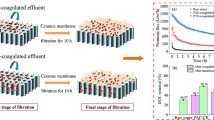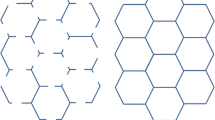Abstract
Ceramic filters have been widely used in industrial engineering, such as the Shell coal gasification process (SCGP) and Integrated gasification combined cycle (IGCC), where the performance of the ceramic filter is achieved by the pulse jet. Residual pressure drop and gas consumption are directly related to reverse-flow pulse (RFP) pressure. However, in the process of operation, the RFP pressure is too large and gas consumption is too high. In this study, the effects of RFP pressures on filter’s cleaning efficiency, residual pressure drop, and gas consumption were investigated on a ceramic filter. Within a certain range, the cleaning efficiency gradually increased with increased RFP pressure. When the RFP pressure reached a certain value, the cleaning efficiency did not increase with increased pressure, showing a quadratic relationship between cleaning efficiency and RFP pressure. The residual pressure drop and RFP pressure were also in a quadratic relationship. Besides, the gas consumption increased linearly as increased RFP pressure according to the theoretical model. Based on the research results, a multi-objective optimization model of a ceramic filter was established with the cleaning efficiency as a constraint condition, gas consumption and residual pressure drop as the optimization objectives. A fuzzy decision-making method was used to solve the optimization model and calculate the residual pressure drop and gas consumption, from which the optimal RFP pressure was obtained.
Similar content being viewed by others
Abbreviations
- G :
-
gas consumption [g]
- p a :
-
absolute pressure of the pulse air tank before pulse jet [MPa]
- p b :
-
absolute pressure of the pulse air tank after pulse jet [MPa]
- T 1 :
-
gas temperature before pulse jet [K]
- V :
-
volume of the pulse-air tank [m3]
- R:
-
gas characteristic constant [287m2·s?2·K?1]
- δpd :
-
pressure drop of the ceramic filter tubes before pulse jet [kPa]
- δpa :
-
pressure drop of the ceramic filter tubes after pulse jet [kPa]
- δp0 :
-
initial pressure drop of the ceramic filter tubes [kPa]
- v :
-
filtration velocity [m/min]
- te]δpra :
-
average residual pressure drop [kPa]
- p 1 :
-
reverse-flow pulse pressure [MPa]
- γ:
-
adiabatic exponent [1.4]
- η:
-
cleaning efficiency [%]
- λ*:
-
fuzzy compromise index
- λ:
-
minimum satisfaction
- ∂1 :
-
standard deviation of the residual pressure drop
- ∂2 :
-
standard deviation of the gas consumption
- μ1 :
-
arithmetic mean value of residual pressure drop
Rererences
S. Heidenreich, Fuel, 104, 83 (2013).
F.P. Nagel, S. Ghosh, C. Pitta, T. J. Schildhauer and S. Biollaz, Biomass Bioenergy, 35, 354 (2011).
J.D. Chung, T.W. Hwang and S. J. Park, Korean J. Chem. Eng., 20, 1118 (2003).
J.H. Choi, S. J. Ha and Y.O. Park, Korean J. Chem. Eng., 19, 711 (2002).
H. X. Li, Z. L. Ji, X. L. Wu and J. H. Choi, Powder Technol., 173, 82 (2007).
I. Schildermans, J. Baeyens and K. Smolders, Filter Sep., 41, 26 (2004).
J.H. Choi, Y.G. Seo and J.W. Chung, Powder Technol., 114, 129 (2001).
M. Lupión, F. J. G. Ortiz, B. Navarrete and V. J. Cortés, Fuel, 89, 848 (2010).
M. Lupion, B. Navarrete, B. A. Fariñas and M.R. Galan, Fuel, 108, 24 (2013).
E. Bakke, J. Air. Pollut. Contr. Assoc., 24, 1150 (1974).
J. Ju, M. S. Chiu and C. Tien, Chem. Eng. Res. Des., 78, 581 (2000).
Z. L. Ji, M. X. Shi and F. X. Ding. Powder Technol., 139, 200 (2004).
I. Schildermans, J. Baeyens and K. Smolders. Filtr. Sep., 26, 41 (2004).
C. Kanaoka and M. Amornkitbamrung, Powder Technol., 118, 113 (2001).
H.C. Chi, Z.L. Ji, D.M. Sun and L.S. Cui, Chin. J. Chem. Eng., 17, 219 (2009).
J. P. Hurley, B. Mukherjee and M.D. Mann, Energy Fuel, 20, 1629 (2006).
A.K. Dhingra and H. Moskowitz, Eur. J. Oper. Res., 53, 348 (2012).
L.M. Kalonda and R. M. Joseph, Int. J. Uncertain. Fuzz., 21, 51 (2013).
Acknowledgements
This research was supported by the National Key Research and Development Program of China (No. 2016YFB0601100).
Author information
Authors and Affiliations
Corresponding author
Rights and permissions
About this article
Cite this article
Liu, L., Ji, Z. & Luan, X. Multi-objective optimization model of high-temperature ceramic filter. Korean J. Chem. Eng. 37, 883–890 (2020). https://doi.org/10.1007/s11814-019-0461-1
Received:
Accepted:
Published:
Issue Date:
DOI: https://doi.org/10.1007/s11814-019-0461-1




